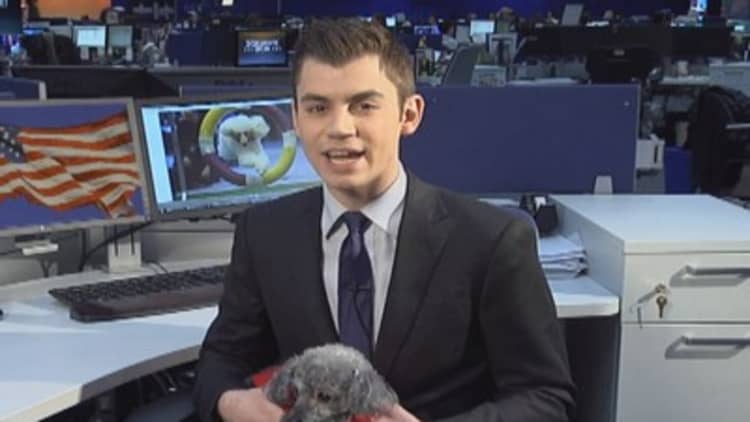
The oldest U.S. dog show will this year open its doors to mixed-breed dogs—or "all-American" dogs, as they're officially classified—allowing a new set of owners to try their hand in the high-priced sport of showing canines.
The Westminster Kennel Club dog show has added an "agility" competition—an event in which dogs leap over hurdles and zigzag through obstacles as quickly as possible—that is open to both purebred and mixed-breed canines. That competition takes place Sat., Feb., 8, and the rest of the show will follow Monday and Tuesday.
(Read more: Unexpected costs come with a $5,000 puppy)
That's in contrast to the traditional "conformation" portion of the show, which accepts only purebred dogs who are judged by their adherence to standards of appearance and behavior.
Dogs that are competitive for top prizes in conformation, like Westminster's coveted "best in show" title, can cost their owners up to about $800,000 per year to maintain and promote, according to 2013 Westminster judge Michael Dougherty.
And for some in the dog world, the addition of mixed breeds to the lineup of a 138-year-old show like Westminster comes as a bit of a shock, said poodle breeder and 2013 Westminster judge Dennis McCoy.
"There are a lot of people who are against it, but there are a lot of people who are OK with it," said McCoy. "Dog shows at one time were limited to purebred dogs, but the world is changing."
(Read more: Can't take Bowser? Board him at the airport)
It's a change in the dynamics of the dog show world that led to the addition of the agility event this year, said Westminster show Chairman Thomas H. Bradley III.
"It came about because agility is a growing division of the sport," said Bradley. "I think it's a great step."
Most Westminster 'Best in Show' winners (1907-2012)
| 13 | Fox terrier (wire) |
| 8 | Scottish terrier |
| 6 | Spaniel (English springer) |
| 4 | Airedale terrier |
| 4 | boxer |
| 4 | Doberman pinscher |
| 4 | Fox terrier (smooth) |
| 4 | Pekinese |
| 4 | Poodle (standard) |
| 4 | Sealyham terrier |
| 3 | Pointer |
| 3 | Poodle (miniature) |
Source: Source: Westminster Kennel Club
Agility is also an event that exhibits some clear cultural differences with conformation, said Stacey Campbell, owner of Roo!—the exclamation point is part of the name—a mixed-breed dog that will be one of 225 canines competing in the agility portion at Westminster.
"I tend to think agility is a little more laid back than conformation," said Campbell. "It's a totally different show."
While agility is designed to be inclusive of any dog that can run and jump, conformation dog owners, said Westminster judge Dougherty, tend to take pride in their dogs' exclusiveness.
"There's a little amount of snob appeal," said Dougherty. "And part of that is rightly so, because generations of people have worked very hard to maintain the purity and level of consistency in the breed."
(Read more: Woof! Start-up DogVacay tackles $11 billion market)
Then, of course, there is the difference in costs involved. Agility dogs are expensive to train and show, but they're nowhere near as costly to manage as conformation dogs.
"I don't even want to know how much I spend," said Aryn Hervel, owner of Crush, another mixed-breed agility dog competing at Westminster.
Hervel said that she spends $120 to $150 every six weeks, or about $1,000 to $1,300 per year, on agility classes for her former shelter dog, and has spent as much as $2,000 over the last 10 years on agility training equipment.
That's in addition to the cost of frequent weekend trips to agility shows near her home in the San Francisco Bay area. Hervel said that each trip costs her around $70, including gas and the event entry fee.
Training a top agility dog pales in comparison to the cost of cultivating a world-class conformation dog, however. The price of a purebred puppy with the makings of a promising show dog can run in the neighborhood of $5,000, said Westminster judge Dougherty.
Once the pup has been purchased, the real work begins. Many owners send their dogs to professional handlers who board, train and show the dogs at hundreds of competitions each year.
"He grows up and goes to live with a professional handler when he's young, and gets schooled and trained, and learns how to stand, and goes on a leash, and is kept in condition depending on what kind of coat he has," said Westminster Chairman Bradley.
According to Maryland-based professional handler Michael Scott, who is showing a top-ranked Portuguese water dog at this year's Westminster, those services aren't cheap.
"If you're trying to make your dog a top dog, we go to over 200 dog shows a year," said Scott. "Not everyone can afford that."
Scott, who has been a professional handler for decades, said he and his wife, also a professional handler, currently board six dogs, and retain the services of one full-time assistant, who is paid between $25,000 and $30,000 per year, in addition to one or two part-time assistants.
Scott says his overhead expenses are in the six figures. "You're easily at a couple hundred thousand dollars a year," he said.
Even so, Scott said he and his wife are able to generate an annual six-figure profit by handling around 20 dogs per show at hundreds of events each year.
(Read more: Can't take Bowser on the trip? Board him at the airport)
"We get a little over $100 per dog per handling per show," said Scott. "We have performance bonuses that we bill out, like $750 for 'best in show.' Right there you're making a couple thousand dollars a day showing dogs."
Top handlers like Scott can make up to $250,000 per year, according to Westminster judge Dougherty.

In addition to costs for handlers, owners also shell out hefty sums to photograph and promote their dogs in publications that are seen by judges and dog world insiders.
"That's called 'campaigning,' " said Dougherty. "You're paying for photographs, and you're paying for advertising. There are probably six to eight all-breed magazines, and then there are breed-specific magazines. That's how they promote themselves."
But once they have campaigned their dogs and won "best in show" at Westminster, what's the return for owners?
(Read more: Cat cafes spring up around the world)
"No money," said Dougherty. "They get a couple of beautiful ribbons, and a trophy, and a memory to last 20 lifetimes."
Then again, there are the potential stud fees, said Westminster Chair Bradley.
"The dog, if it's a male, will become a very popular stud dog," said Bradley. "But nothing like horses. It's minor, maybe a few thousand dollars tops per year."
—By CNBC's Adam Molon. Follow him on Twitter: @CNBCMolon.




